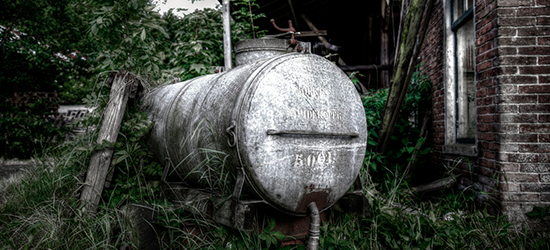
Updated January 23, 2023
If there's an oil tank on your property, leaks are something to monitor.
A small leak may seem harmless, but in fact, it's far from it.
That's why it's so important to be on the lookout for signs of oil tank wear and tear or an existing leak.
Make sure you're protected and keep an eye out for these disaster signs!
The warning signs for an above ground oil tank will differ from those of an underground oil tank; however, some of the most recognizable (and foreshadowing) signs of trouble are true for both styles of oil tanks, including:
1. Visible wet spots
If you see any wet spots—whether underneath an above ground tank or on the ground above an underground tank—it's one of the clearest indicators of an oil tank leak.
Above ground oil tanks make it easier to catch wet spots, but they can still go unnoticed if you don't inspect your tank properly on a regular basis.
Damp spots commonly appear on the underside of the tank or along the seam of the tank.
Another spot to check for stray oil is near the fuel gauge.
2. Equipment isn't functioning properly
Many oil tank problems arise because of poor installation.
One of the quickest ways to spot a poorly installed tank is if the legs seem uneven or unstable in any way.
Fix broken fuel gauges and vent alarms immediately.
Not doing so will greatly disrupt the tank's ability to function properly and will increase the risk of leaks occurring (if they haven't already).
Similarly, inspect the lines to be sure oil is being carried to and from the tank properly.
If the line is cracked or split at all, have a professional out ASAP.
3. An unexplained spike in oil use
If you're going through oil quicker than normal for no apparent reason, then it's likely you have a leak somewhere. Have your tank inspected, or simply have it removed and replaced if necessary.
4. Exposed to the elements
Cold months of the year pose the biggest threat to oil tanks, as this is when they are most vulnerable to corrosion and leaks.
This is another reason why it's important to have your tank inspected regularly, or removed if it is decommissioned.
5. Rust or dents
Along the same lines as being exposed to the elements, corrosion can contribute to oil tank leaks.
Dent marks are particularly high-risk for corroding, and the bottom line is: Rust and dents are a sign that your tank isn't operating as it should and poses significant health risks.
Keep reading:


